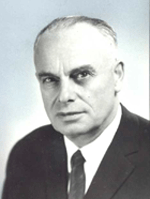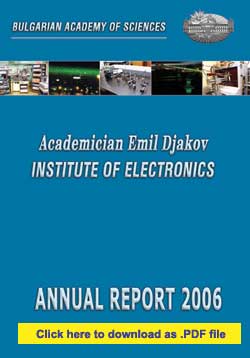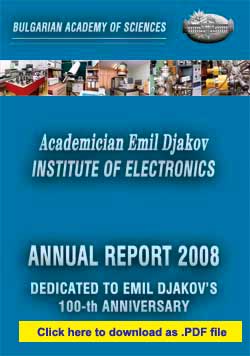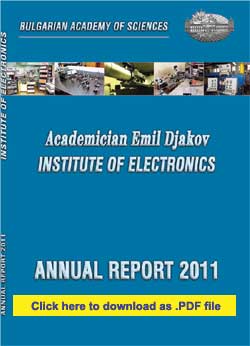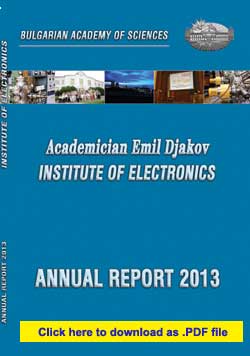
ACADEMICIAN EMIL DJAKOV INSTITUTE OF ELECTRONICS
BULGARIAN ACADEMY OF SCIENCES
72, Tzarigradsko chaussee blvd, 1784-Sofia, Bulgaria

|
|
|
 |
|
| PRESENTATION |

ABOUT THE ACADEMICIAN EMIL DJAKOV INSTITUTE OF ELECTRONICS
In its quality of a part of the Bulgarian Academy of Sciences, the Institute's mission is to acquire, accumulate and disseminate scientific knowledge and technologies in its research field, thus contributing to Bulgarian people's intellectual and material enrichment and to widening humankind's scientific horizons.
The Institute of Electronics at the Bulgarian Academy of Sciences was established in 1963 as a non-profit state organization conducting research, education and dissemination of scientific knowledge in the fields of Physical Electronics, Photonics and Quantum Electronics and Radio Sciences. Soon, the Institute of Electronics evolved as a leading scientific institution in these areas of applied physics and engineering within the Bulgarian Academy of Sciences and in Bulgaria.
Through the years, the Institute's research field and structure have developed dynamically in response to the changes taking place in the main trends in applied physics and technologies: materials science and technologies, physics of nano-sized objects and nanotechnologies, nanoelectronics, photonics, opto-electronics, quantum optics, environmental physics and monitoring, biomedical photonics and biomedical applications.
The Institute's main areas of scientific development have been preserved, while the specific research today takes into account the contemporary problems and requirements, the world-wide tendencies and Bulgaria's specificity and traditions.
The research efforts in physical electronics are concentrated on studying and solving the problems of generating and controlling electron and ion beams and their interaction with materials. This includes theoretical modeling, modern techniques, research and industrial equipment for micro- and nano-structuring, thin films deposition and study, modification of surfaces, vacuum melting and welding of metals by intense electron beams. The physical basis is being formed of creating nanostructures, nanomaterials and nanoelements by using electron and ion beams. Furthermore, fundamental properties are being investigated of gasses and gas plasma, plasma arcs and plasma torches in view of developing diagnostic techniques and applications in thin films deposition and plasma chemistry.
The research in photonics and quantum electronics comprises theoretical and experimental studies on the interaction of short and ultrashort lasers pulses with matter; development of novel nanostructuring technologies; laser thin-films deposition and treatment; light-induced absorption and transmission in alkaline vapors; development of complex laser systems for analysis and modification of semiconducting and superconducting materials; theoretical and experimental investigation of non-linear optical phenomena; biomedical photonics.
The research efforts in radiophysics are directed to clarifying the processes of interaction of optical and microwave electromagnetic radiation with the atmosphere and the Earth's surface; developing experimental systems for laser remote sensing and monitoring of the atmosphere; microwave remote radiometric measurement of soil moisture content; developing algorithms and techniques for signals and information processing; constructing microwave units and systems for radar and communication applications; studying non-linear processes in optical communication media. New ferrite devices with micrometric dimensions were developed with possibility for a higher degree of integration. Active research on gyro-magnetic materials is underway, in view of reaching higher frequency ranges, especially mm-waves for wireless communications and protection from powerful microwave radiation.
In all three fields of research, the Institute's scientists have achieved internationally-recognized priority by discovering new physical phenomena and relations, among which are ion channeling in the semi-channels of a crystal surface and hyperchanneling at grazing angles; ion-stimulated sorption; plasma electrodes for gas lasers; particularities in the interaction of electron and ion beams with materials; electromagnetically induced absorption in Hanle configuration.
Scientists from the Institute are actively involved as experts in the work of a number of governmental and international organizations, such as the National Scientific Fund, scientific boards at other institutes within the Bulgarian Academy of Sciences, academic boards of universities, editorial boards of Bulgarian and international scientific journals, expert boards of the European Commission, program committees of national and international scientific events.
Scientists from the Institute are delivering 35 academic courses in ten universities in Bulgaria and have been invited to lecture at universities in the European Union, Japan, etc. At present, eight doctoral students are preparing their theses in the Institute.
| The Academician Emil Djakov Institute of Electronics was where the first Bulgarian laser, lidar, plasma torch, ultrahigh vacuum pump, micro-channel electron-optical converter, parametric microwave amplifier, Josephson junctions and SQUID, portable microwave moisture meter, magnetometer, installations for electron lithography, electron beam melting, refining, and welding were built, followed by the development of several advanced e-beam technologies, novel types of optical gas sensors, pioneering achievements in nanostructuring and nanoparticle formation, laser and plasma high technologies. |
The Academician Emil Djakov Institute of Electronics aims to sustain and advance previous pioneering work by promoting the theory, basic science and technology of photonics, optoelectronics, environmental monitoring, laser bio-medical research and applications. This involves searching for new materials, new techniques, new devices and new applications.
STRATEGIC PLAN AND PRIORITIES FOR 2023-2025
The strategic plan for the research activities of the Institute of Electronics is based on the priorities of the National Strategy for Scientific Development in the Republic of Bulgaria 2017-2030 and the Strategy for Development of the Bulgarian Academy of Sciences 2018-2030.
The plan includes continuation of the long-term and short-term research investigations, as well as development of prospective interdisciplinary collaborations within the Bulgarian Academy of Sciences, at a national and international level.
The physical and engineering sciences are key driving forces for the research and innovation, providing fundamental knowledge and novel applications.
The strategic plan for scientific research of the Institute of Electronics is based on the highly competitive outcomes and achievements of its researchers and laboratory teams. It also corresponds to the newly emerging research trends and scientific areas. The research and educational activity of the Institute is becoming more complex and interdisciplinary. The research priorities of the Institute of Electronics for the following three years are as follows:
- Topic 1. Methods for development and processing of novel materials and their characterization. Nanomaterials, technologies and applications.
- 1.1. Electron technologies
- 1.2. Ion technologies
- 1.3. Optical technologies
- 1.4. Plasma technologies
- 1.5. Microwave technologies
- 1.6. Novel multifunctional optical, magnetic, superconducting and biomimetic materials
- 1.7. Modification and functionalization of materials for different applications
- Topic 2. Biomedicine, health and quality of life.
- 2.1. Biophotonics and nanomedicine. Teranostics of socially significant diseases.
- 2.2. Remote lidar and photometric studies of aerosol processes and pollution in the atmosphere, including investigations as a member of the pan-European research infrastructure ACTRIS.
- 2.3. Investigation and development of sensors for mechanical, chemical and electromagnetic pollution of the natural and working environment.
- Topic 3. Research in the field of the controlled thermonuclear fusion.
- 3.1. Remote lidar diagnostics of thermonuclear plasma.
- 3.2. Probe diagnostics of high temperature tokamak fusion plasma.
- 3.3. Theoretical and numerical investigations of high-power sub-terahertz and terahertz gyrotrons.
- Topic 4. Theoretical and experimental investigations and modeling of the interaction of electromagnetic radiation and beams of charged particles with matter.
- 4.1. Nonlinear processes in the propagation of ultrashort laser pulses.
- 4.2. Nonlinear and coherent processes in the interaction of laser radiation with atoms and molecules.
- 4.3. Interaction of light, including with ultrashort duration, with matter, as well as with nanostructures and biological objects.
- 4.4. Propagation of microwave radiation above ground and sea surface.
- 4.5. Processes in the interaction of electron and ion beams with matter.
- 4.6. Modeling of novel materials and simulation of their basic characteristics
ARCHIVE:
- STRATEGIC PLAN AND PRIORITIES FOR 2020-2022
- STRATEGIC PLAN AND PRIORITIES FOR 2017-2019
